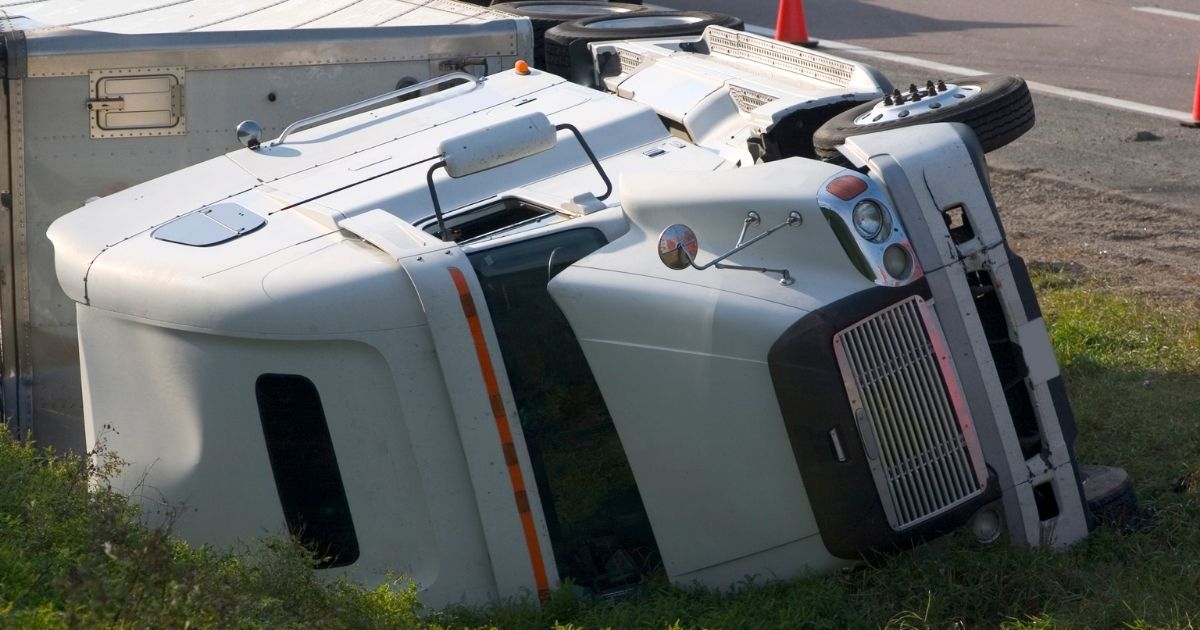Commercial trucks are a common sight on the road, serving businesses and transporting a variety of goods. Their size and weight make them a challenge to maneuver and brake compared to automobiles, and this is especially true with fully loaded trucks. When one collides with a passenger vehicle, the physical differences mean damage to the smaller vehicle is substantial.
Truck accidents may be the direct result of driver error. There can also be other factors, such as poor road conditions, severe weather and equipment failure. Disputes involving truck accidents can be challenging and are best settled with experienced attorneys. Here is an overview of collision types and their causes.
Jackknife
This type of incident occurs when tractor trailer drivers turn improperly or brakes too hard and fast. The vehicle pivots, causing the cab to turn at a right angle against the trailer. Its back end may fishtail, or swing out of control, and the truck may be in danger of tipping. Jackknifing trucks can strike other vehicles as they move, and cause multi-car pileups when still.
Wide Turn
Right hand turns are tighter for trucks than left hand. Drivers may compensate for this challenge by steering left before swinging around to the right. This wide turn may cause neighboring vehicles to crash into the trailer’s sides or get caught beneath the truck. The Federal Motor Carrier Safety Administration (FMCSA) recommends truck drivers travel to the rightmost lane before turning into the closest lane of the other road.
T-Bone
A side impact accident where a truck strikes a vehicle at a perpendicular angle is called a T-bone crash. Between a truck’s mass and vehicle sides leaving little buffer between the collision and rider, these impacts can be devastating. They often happen at intersections where speeding or negligence leads to ignoring the red light or otherwise failing to yield.
Side Swipe
Side swipes are when vehicles crash while traveling side by side in the same direction. The initial collision may lead to the truck or car drifting into other lanes, hitting more vehicles. Road obstacles or poor weather may lead to side swipes.
Rear-End Collisions
Rear-end collisions happen when one vehicle crashes into the back of another. If a truck follows another vehicle too closely, the driver may not be able to brake in time to avoid striking. Even if the truck driver is attentive to the actions of the other motorist, it does not compensate for insufficient distance. The Federal Motor Carrier Safety Administration (FMCSA) recommends trucks traveling over 40 miles per hour leave one or more seconds for every 10 feet between them and the other vehicle. For greater speeds or inclement weather, drivers should allow for more time.
Tire Blowout
Commercial truck tires bear immense weight. Even with 18 wheels to distribute pressure, tires still experience wear and tear. Potholes, manufacturing defects, poor maintenance, hot weather and overloading may further harm them. When a weakened tire is subject to sudden pressure or impact, it can break, sending the truck out of control. Possible outcomes include head on collisions, side swipes and rollovers.
Truck Rollovers
Commercial trucks have a higher center of gravity than sedans. This increases the risk of drivers losing control and their trucks sliding and rolling onto their sides. Multi vehicle collisions are possible during these accidents.
Rollovers happen when the truck swerves or turns too quickly. Causes may come from speeding, fatigue or distracted driving. Some elements may be beyond the driver’s control such as poor weather, low road visibility or reckless behavior from other motorists.
Head On Collisions
These occur when the front end of a truck crashes with the front end of another vehicle traveling the opposite direction. Head on collisions may happen when a vehicle travels directly into oncoming traffic or overlooks the right of way at intersections. If a truck is experiencing a rollover, other motorists may swerve out of the way, leading to secondary head on crashes.
Though accidents themselves are quite visible, their causes are not always apparent. Several factors may be involved, and multiple parties liable, both directly and indirectly. A knowledgeable truck accident attorney will provide legal guidance.
What Are Common Causes of Truck Accidents?
Speeding
Drivers may be under pressure to travel under unrealistic schedules, and drive faster than is safe. A truck’s mass makes it take longer to stop or change the direction of its momentum. An automobile may not be able to get out of the way in time to avoid a collision.
Distracted Driving
Driving for hours can be monotonous. During these long stretches of time, the driver may risk playing with the radio, eating, texting, or otherwise diverting their attention. Taking their eyes off the road, even for instant, may cause accidents.
Fatigue
The FMSCA has detailed regulations regarding rest breaks, sleep requirements and how many hours a truck driver may work. Company culture and tight deadlines can lead to hours-of-service violations, causing driver fatigue. In this condition, reaction times decrease, as do concentration and coordination.
Drug and Alcohol Use
To combat fatigue and stress while maintaining intense schedules, drivers may turn to amphetamines and other stimulants. Rather than promote alertness, these impair cognitive and executive functioning. After the drugs wear off, the risk of falling asleep at the wheel increases.
FMCSA regulations state truck drivers must have a blood alcohol concentration of under 0.4%. Drivers who violate this rule have decreased cognition and are more likely to engage in risky behavior on the road. These components make alcohol responsible for a significant number of collision injuries.
Inadequate or Improper Training
The FMCSA has extensive requirements regarding instructor qualifications for both classroom and practical training. Their curriculums must cover a wide range of subjects including pre- and post- travel vehicle inspections, extreme driving conditions and skidding control and recovery. Standards for completing training is also strict. In collisions where poor training is an element, they and those who provided insufficient instruction may both be liable.
Severe Weather
Heavy precipitation can reduce traction on the road. Fog, snow and other conditions reduce visibility, and strong winds can blow debris into traffic. These circumstances require especially careful driving, such as slower than usual speeds. Unreasonable schedules, drug use or other matters may lead the driver to overlook precautions.
Overloading Cargo
Trucks weigh tens of thousands of pounds, and cargo adds to this mass. Too much weight can lead to rollovers or tire blowouts. If the freight is external, improperly secured materials may fall onto the road, striking other vehicles or causing them to swerve. The driver as well as companies who allow poor loading may be held responsible.
Mechanical Malfunction or Poor Maintenance
Drivers spend many hours on the road, as do their trucks. This leads to wear and tear on the vehicles, and higher risk of parts failure leading to an accident. Quality routine inspections and maintenance are essential.
Determining who is liable for mechanical malfunction can be complex. Pieces may have been manufactured with defects, the truck company conducted poor maintenance or the driver neglected inspections. Still another party, like the vehicle’s owner, may also be liable. An experienced truck accident lawyer will help their client navigate this process.
Contact a Wright & Schulte LLC Truck Accident Lawyer Today
If you or a loved one suffered injury in a truck accident, our attorneys can help. Our Dayton truck accident lawyers at Wright & Schulte LLC can help. For a free, no obligation legal evaluation of your case, fill out our online form or call us at (937)-222-7477. With our offices based in Dayon, we serve clients in Dayton, Cincinnati, Columbus, Cleveland, Centerville, Toledo, Youngstown, and Miamisburg.



